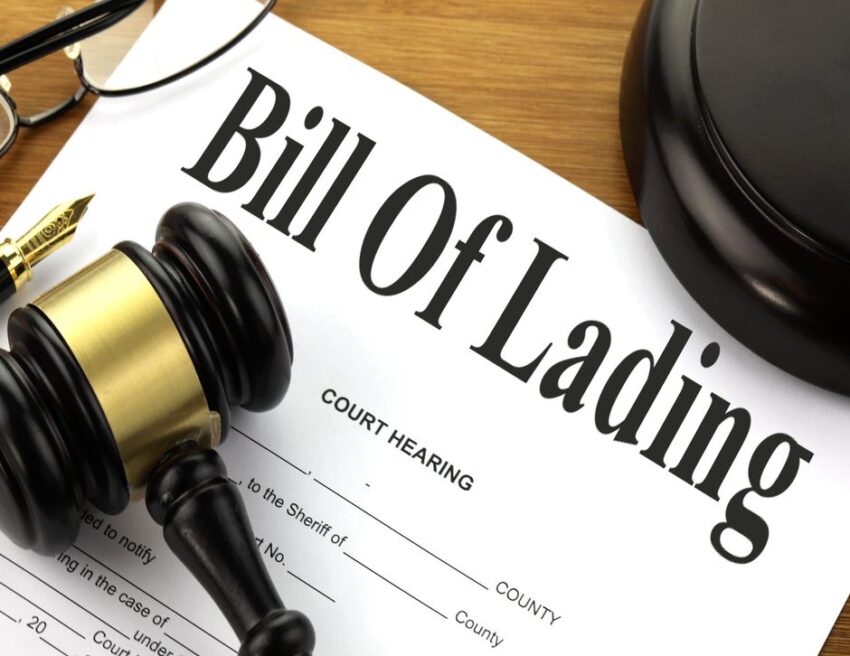A Bill of Lading aka B/L, BoL, and Waybill is the most important paperwork you, as an independent freight forwarder, need to handle for any international movement of goods. No matter the kind of cargo you are moving or the mode of transportation, you will need the Bill of Lading. It can be defined as a legal document that the carrier issues to the independent freight forwarder in charge of the shipment. This document comes with all the important shipment details like volume, destination, and commodity type. This article is a brief guide to Bill of Lading, where are have talked about its uses, all its different types, and the kind of information you need to provide the carrier for preparing this document.

What information does the Bill of Lading contain?
This legally binding document works as evidence of the shipment. Apart from listing the parties involved in the movement of the shipment, it also comes with the following information:
- Name and addresses of both the shipper and consignee
- Reference number/purchase order
- Shipment pickup date
- Cargo description
- Shipment weight
- Packaging details
- Details of the independent freight forwarder in charge
- Special notes or instructions
It is the duty of the carrier to fill out this information. However, as the freight forwarder, your job is to provide the carrier with the correct information. This will ensure the accuracy of the information listed on the document.
What information should an independent freight forwarder provide the carrier for making the B/L?
Listed below are the information you need to provide the carrier for preparing the B/L accurately.
- Your full name and address.
- Name and address of the recipient.
- The name and address of the party who should be notified of the cargo status. This party could be the receiver or the clearing agent who’s handling the shipment clearance on the consignee’s behalf.
- The booking number and the Bill of Lading number.
- The Purchase Order number or any other reference number allows you to identify the cargo within your internal system.
- Markings on the packing of the shipment that will be used for identification. For LCL cargo you have to provide the number on the label on the carton or the shrinkwrap around the pallet. For FCL shipment you need to provide the container number. It is also important for you to remember the container seal number.
- The number of parcels. For FCL shipment, you just need to mention the number of containers. For LCL, you need to mention the number of packages in the largest unit. You also need to provide the details of the total number of packages including LCL and FCL.
- Package description- You need to specify every detail of the cargo in its smallest units, the quantity of goods per package, and the type of package.
- You need to provide the carrier with special handling instructions if any.
- You have to calculate the net weight of the shipment in kilograms for every item. If you are shipping to/from the US, the weight should be provided in both pounds and kilograms.
- Lastly, you have to provide the carrier with an accurate measurement of the cargo dimension for each package you’re moving. However, this information is not needed in most countries for FCL shipments.
What are the uses of the Bill of Lading?
The Bill of Lading has three important uses:
-
It works like a receipt of the cargo
You cannot execute a shipment without a B/L. It has to be issued to move cargo from one place to another. They also work as proof of ownership of the shipment.
-
B/L is also a document of a title of goods
When the shipment reaches the destination, the B/L works like a title to the cargo. The listed consignee needs to provide this document to release the cargo and claim ownership. In other words, it works like an evidence that the cargo has been delivered.
-
B/L make sure that the shipper receives their payment
As the independent freight forwarder, you can hold the original Bill of Lading until you receive the payment. This ensures that the receiver is not able to access the cargo until payment has been made to you. The consignee can only access the cargo when you release the B/L.
Different types of Bill of Lading
Air Waybill
This is the document that accompanies the cargo that is shipped via international airlines. AWB, also referred to as air consignment note is distributed by the IATA.
Rail Waybill
Rail Waybill that is prepared by the railway line is issued for rail shipments.
Road Waybill
If you are moving road freight, then you will receive a Road Waybill from your carrier. You as well as your drivers can use this international consignment note to move road freight internationally.
Master Bill of Lading
This document is issued to you by the shipping carrier.
House Bill of Lading
You as the forwarder, need to issue this kind of B/L to the exporter of the cargo. They come with the terms and conditions specified by you.
Straight Bill of Lading
This kind of B/L is important for shipments being sent directly to the customers who have already paid in advance for the cargo. This is a non-negotiable document that the specified consignee cannot resign to another party’s name.
Sea Waybill/Express Bill of Lading
Express B/L or Sea Waybill is a digital document of the B/L as opposed to the hard copy. This document is used only when you have a long-standing relationship with the consignee. Express B/L can be very efficient as they allow you to forego the cost of issuing and shipping the B/L. Additionally, they allow the consignees to release the shipment as soon as they reach the port.
Switch Bill of Lading
Switch B/L is a second set of B/L that the carrier issues to replace the original document issued during the shipping process. However, the info on the Switch Bill of Lading isn’t always similar to the original document it replaces.
Order Bill of Lading
This is one of the most common types of B/L where the payment for the cargo is due. The receiver can endorse the B/L to another party and order the cargo to be delivered in their name.
Bearer Bill of Lading
This B/L is issued when the bearer of the bill is also the shipment owner. Simply put, there is no consignee in this kind of B/L and the bill ownership can be transferred.
Foul or Claused Bill of Lading
The Foul Bill of Lading is issued by the carrier when the shipment is damaged or when it doesn’t meet the mentioned specifications. This B/L also highlights the kinds of damage or discrepancy in the shipment. Moreover, it is within the power of the consignee to reject a cargo with a Claused B/L.
Clean Bill of Lading
This B/L is issued to declare that the cargo is in its intact condition during the shipping process. It is issued after the shipment inspection. This document is mandatory for completing the requirements of the letter of credit.
Surrender Bill of Lading
This B/L comes with the terms whereby the documents can only be released after providing the receipt issued by the negotiating bank.
Through Bill of Lading
Through Bill of Lading permits the carrier to move the cargo via various distribution centres. Moreover, the carrier is also allowed to use one or more transportation modes. It requires an Ocean B/L or Inland B/L depending on the transportation mode.
Stale Bill of Lading
The Stale B/L is issued 21 days after the shipment date for negotiation purposes.
Charter Party Bill of Lading
This B/L is an agreement between a vessel owner and the charterer for the cargo.
Short Form Bill of Lading
This kind of B/L comes into the picture when the terms of the contract are not mentioned in the original B/L.
Container Bill of Lading
This B/L suggests that the shipment has been delivered in a secure container from the port of origin to the destination port via the transshipment port.
Received for shipment Bill of Lading
The carrier issues this document as an acknowledgment receipt of goods of shipping before loading the vessel. However, the Received B/L is not an onboard B/L.
Telex Release for the Original Bill of Lading
The Digital Cargo Release or Telex Release is a service that allows the cargo to be released without providing a paper copy of the original B/L. Although there is no alternative for hard copies of the B/L, the Telex Release can be used to release the shipment. Additionally, it expedites customs clearance and eliminates the shipping cost of sending the original B/L.


